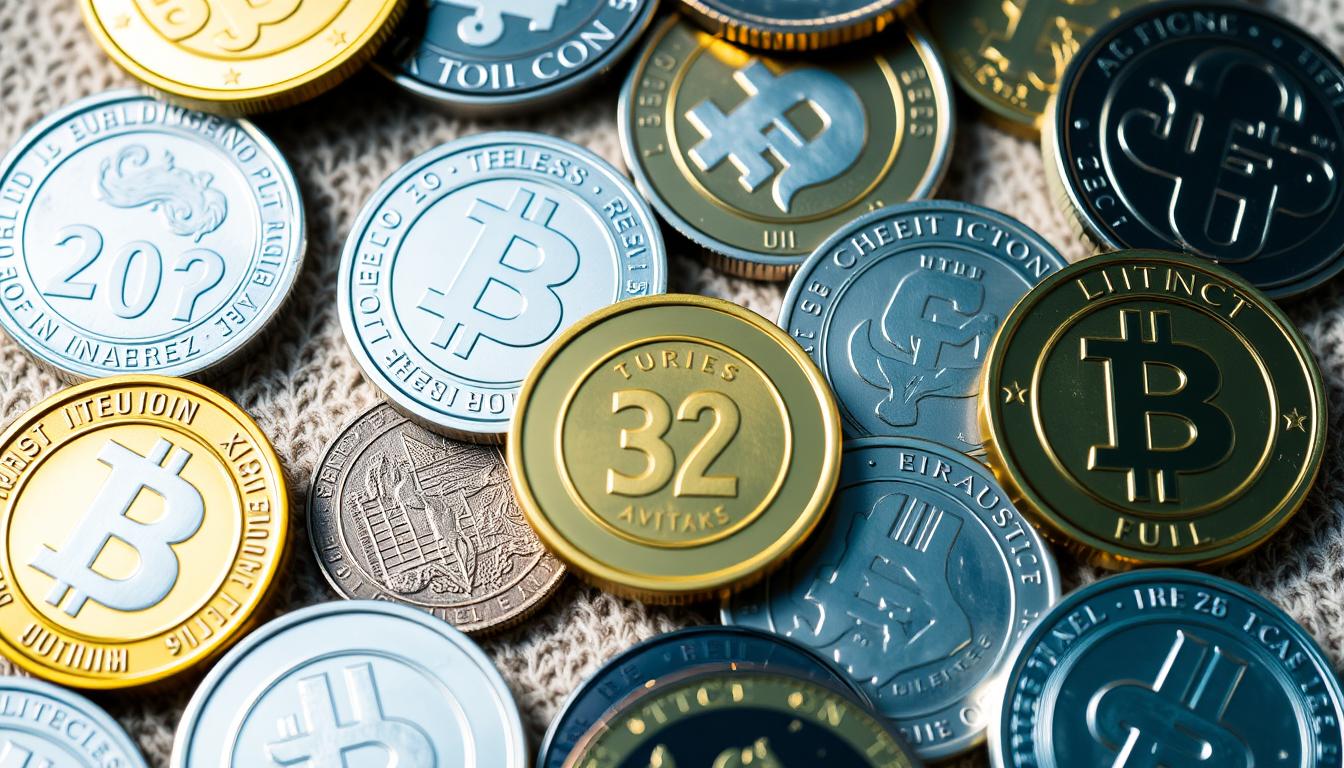Now Reading: Stablecoins and Their Many Uses: A Helpful How-to
- 01
Stablecoins and Their Many Uses: A Helpful How-to
Stablecoins and Their Many Uses: A Helpful How-to

Stablecoins are a type of digital asset that has gained significant attention in recent years due to their potential to reduce the volatility associated with cryptocurrencies. As a key component of the digital finance ecosystem, stablecoins play a crucial role in facilitating transactions and providing a stable store of value. In the world of digital assets, stablecoins have emerged as a vital tool for investors and users alike, offering a range of benefits and use cases that will be explored in this article.
From their role in facilitating international transactions to their use in decentralized finance (DeFi) applications, stablecoins are an essential part of the digital asset landscape. As the use of cryptocurrencies and digital assets continues to grow, understanding the fundamentals of stablecoins and their many uses is becoming increasingly important. This article will provide an overview of the key concepts and applications of stablecoins, highlighting their significance in the world of digital finance and their potential to shape the future of financial transactions.
Understanding the Fundamentals of Stablecoins
Stablecoins are a type of cryptocurrency that has gained popularity in recent years due to their ability to mitigate the volatility associated with the cryptocurrency market. By utilizing blockchain technology, stablecoins are able to provide a more stable store of value, making them an attractive option for investors and users alike. The integration of stablecoins into the decentralized finance ecosystem has also enabled the creation of new financial instruments and platforms, further expanding their potential use cases.
The concept of stablecoins is rooted in the idea of pegging the value of a cryptocurrency to a stable asset, such as a fiat currency or a commodity. This is achieved through various methods, including collateralization and algorithmic stabilization. The use of stablecoins in the cryptocurrency market has also led to the development of new trading strategies and investment opportunities, as they provide a more predictable and stable store of value.
What Makes a Cryptocurrency “Stable”
A cryptocurrency is considered stable if its value remains relatively constant over time. This can be achieved through the use of a stablecoin, which is designed to maintain a stable value relative to a fiat currency or other asset. The stability of a cryptocurrency is crucial in the decentralized finance ecosystem, as it enables the creation of more complex financial instruments and platforms.
Different Types of Stablecoin Backing
There are several types of stablecoin backing, including fiat-collateralized, commodity-collateralized, and algorithmic stabilization. Each type of backing has its own advantages and disadvantages, and the choice of backing will depend on the specific use case and requirements of the stablecoin. The use of stablecoins in the cryptocurrency market has also led to the development of new types of backing, such as hybrid backing, which combines elements of multiple backing types.
The Role of Stablecoins in Crypto Markets
Stablecoins play a crucial role in the cryptocurrency market, as they provide a more stable store of value and enable the creation of more complex financial instruments and platforms. The use of stablecoins has also led to the development of new trading strategies and investment opportunities, as they provide a more predictable and stable store of value. The integration of stablecoins into the decentralized finance ecosystem has also enabled the creation of new financial instruments and platforms, further expanding their potential use cases.
The following are some key benefits of stablecoins in the cryptocurrency market:
- Reduced volatility: Stablecoins provide a more stable store of value, reducing the risk of price fluctuations.
- Increased liquidity: Stablecoins can increase liquidity in the cryptocurrency market, making it easier to buy and sell assets.
- Improved stability: Stablecoins can provide a more stable store of value, making them an attractive option for investors and users alike.
The Evolution of Digital Currency Stability
The development of stablecoins has marked a significant milestone in the evolution of digital currency stability. As the cryptocurrency market continues to grow, the benefits of stablecoins have become increasingly apparent, driving their adoption in various industries. Stablecoin benefits, such as reduced price volatility, have made them an attractive option for investors and users alike.
One of the primary factors contributing to the growth of stablecoin adoption is their ability to provide a stable store of value. This has led to increased usage in cross-border transactions, where the stability of the currency is crucial. Stablecoins have also enabled the creation of new financial instruments and platforms, further expanding their reach and applications.
Some of the key advantages of stablecoins include:
- Price stability, which reduces the risk of significant price fluctuations
- Increased liquidity, making it easier to buy and sell stablecoins
- Improved security, through the use of robust smart contracts and auditing mechanisms
As the use of stablecoins continues to expand, it is likely that we will see increased innovation and development in the space. With the potential to revolutionize the way we think about digital finance, stablecoin adoption is poised to play a major role in shaping the future of the industry.
Stablecoins have the potential to bring stability and transparency to the world of digital finance, and their adoption is likely to have a significant impact on the industry as a whole.
| Stablecoin | Backing | Stablecoin Benefits |
|---|---|---|
| Tether | US Dollar | Price stability, liquidity |
| USDC | US Dollar | Transparency, security |
Key Features That Make Stablecoins Valuable
Stablecoins have gained popularity due to their unique characteristics, making them an attractive option for investors and users. One of the primary features of stablecoins is their ability to facilitate stablecoin transactions, which are essential for businesses and individuals alike. The stability of these coins is maintained through various mechanisms, including reserve assets and algorithms.
The transparency and auditability of stablecoins are also crucial factors that contribute to their value. Investors can track the flow of funds and verify the reserves backing the stablecoin, which helps to build trust and confidence in stablecoin investments. Furthermore, the global accessibility of stablecoins enables users to conduct cross-border transactions efficiently and cost-effectively.

Price Stability Mechanisms
Stablecoins employ various price stability mechanisms to maintain their value. These mechanisms include pegging the stablecoin to a fiat currency, using a basket of assets as collateral, or implementing algorithms that adjust the supply of stablecoins in response to changes in demand.
Transparency and Auditability
Transparent and auditable stablecoins provide users with a clear understanding of the underlying assets and the flow of funds. This transparency helps to prevent fraudulent activities and ensures that the stablecoin is backed by sufficient reserves.
Global Accessibility
The global accessibility of stablecoins enables users to conduct transactions across borders, without the need for intermediaries. This feature makes stablecoins an attractive option for individuals and businesses that need to transfer funds internationally.
Popular Stablecoins and Their Uses
Stablecoins have become a crucial part of the cryptocurrencies ecosystem, offering a stable store of value and a means of exchange. They are digital assets designed to maintain a stable value relative to a fiat currency, such as the US dollar.
Some popular stablecoins include:
- Tether (USDT)
- USD Coin (USDC)
- Paxos Standard (PAX)
These stablecoins have various use cases, including cross-border payments, decentralized finance, and trading. They provide a stable means of exchange, allowing users to transfer value without the volatility associated with other cryptocurrencies.
As the use of stablecoins continues to grow, they are becoming an essential part of the digital assets landscape. Their stability and versatility make them an attractive option for individuals and businesses looking to utilize cryptocurrencies for various purposes.
Stablecoins have the potential to revolutionize the way we think about money and financial transactions, offering a stable and secure means of exchange in the digital age.
Getting Started with Stablecoin Transactions
To begin with stablecoin transactions, it’s essential to understand the role of blockchain technology in facilitating secure and transparent transactions. Stablecoins are a crucial component of decentralized finance, enabling users to participate in various financial activities without the need for traditional banking systems.
Setting up a digital wallet is the first step in getting started with stablecoin transactions. This involves choosing a reputable wallet provider that supports stablecoins and follows best practices in security and transparency. Some popular digital wallet options include MetaMask and Trust Wallet.
Key Steps to Get Started
- Research and choose a reputable digital wallet provider
- Set up your digital wallet and enable two-factor authentication
- Purchase your first stablecoins from a reputable exchange or broker
When purchasing stablecoins, it’s crucial to follow security best practices to protect your assets. This includes using strong passwords, enabling two-factor authentication, and regularly updating your wallet software. By following these steps and using blockchain technology to facilitate transactions, users can participate in decentralized finance with confidence.
As the use of stablecoins continues to grow, it’s likely that we’ll see increased adoption of blockchain technology and decentralized finance in various industries. By getting started with stablecoin transactions, users can be at the forefront of this innovation and take advantage of the benefits that blockchain technology has to offer.
| Stablecoin | Backing | Market Capitalization |
|---|---|---|
| Tether (USDT) | US Dollar | $68 billion |
| USD Coin (USDC) | US Dollar | $53 billion |
| Binance USD (BUSD) | US Dollar | $12 billion |
Practical Applications in Everyday Finance
The use of stablecoins in everyday finance has numerous benefits, including increased financial inclusion and reduced transaction costs. Stablecoin adoption is on the rise, with many individuals and businesses using them for payments, remittances, and lending.
Some of the practical applications of stablecoins include:
- Fast and low-cost cross-border transactions
- Microfinance and lending to underserved communities
- Stable store of value for individuals and businesses
The stablecoin benefits are clear, with many users experiencing increased financial freedom and flexibility. As stablecoin adoption continues to grow, we can expect to see even more innovative applications in the future.
Overall, the use of stablecoins in everyday finance has the potential to transform the way we think about money and financial transactions. With their numerous benefits and growing adoption, stablecoins are an exciting development in the world of finance.
Stablecoins in Decentralized Finance (DeFi)
Decentralized finance, or DeFi, has revolutionized the cryptocurrency market by providing a wide range of financial services without the need for traditional intermediaries. Stablecoins play a crucial role in this ecosystem, offering a stable store of value and a medium of exchange. In the DeFi space, stablecoins are used for various applications, including lending, borrowing, and yield farming.
The use of stablecoins in DeFi has opened up new opportunities for investors and users, providing a more stable and secure way to participate in the cryptocurrency market. With the help of stablecoins, users can lend and borrow assets, generate yields, and provide liquidity to decentralized protocols. This has created a more efficient and transparent financial system, where users have more control over their assets and can participate in a wide range of financial activities.
Lending and Borrowing
In the DeFi space, lending and borrowing are facilitated through decentralized lending protocols, which use stablecoins as collateral. This allows users to lend and borrow assets in a trustless and permissionless manner, without the need for intermediaries. The use of stablecoins in lending and borrowing has created a more stable and secure way to participate in the cryptocurrency market, reducing the risk of price volatility and providing a more predictable return on investment.
Yield Farming Opportunities
Yield farming is another popular application of stablecoins in DeFi, where users can generate yields by providing liquidity to decentralized protocols. This has created a new way for users to earn passive income, by providing liquidity to protocols and earning rewards in the form of tokens or interest. The use of stablecoins in yield farming has made it possible for users to participate in this activity without exposing themselves to the risks of price volatility.
In the decentralized finance ecosystem, stablecoins have become an essential component, providing a stable store of value and a medium of exchange. As the cryptocurrency market continues to evolve, the use of stablecoins in DeFi is likely to play an increasingly important role, providing a more stable and secure way to participate in the market and creating new opportunities for investors and users.
International Money Transfers with Stablecoins
Stablecoin transactions have revolutionized the way people send and receive money across borders. With the help of stablecoin investments, individuals and businesses can now transfer funds quickly and securely, without the need for traditional banking systems. The benefits of using stablecoins for international money transfers include lower transaction fees, increased efficiency, and enhanced security features.
The use of stablecoins for cross-border transactions has the potential to drive financial inclusion and economic growth, particularly in developing economies. Stablecoin transactions can provide access to financial services for underserved populations, enabling them to participate in the global economy. Additionally, stablecoin investments can help reduce the costs associated with traditional payment systems, making it more affordable for people to send and receive money across borders.
Some of the advantages of using stablecoins for international money transfers include:
- Fast transaction processing times
- Low transaction fees
- Enhanced security features
- Increased accessibility
Overall, stablecoin transactions and stablecoin investments have the potential to disrupt traditional payment systems and provide a more efficient, secure, and accessible way to transfer funds across borders.
Risk Management and Security Considerations
As the use of stablecoins continues to grow in the realm of decentralized finance, it’s essential to address the risk management and security considerations associated with these digital assets. The integration of blockchain technology has enhanced the security and transparency of stablecoin transactions, but it’s crucial to be aware of potential threats and take proactive measures to mitigate them.
Some common security threats include hacking, phishing, and smart contract vulnerabilities. To protect against these threats, it’s vital to implement robust security protocols, such as multi-factor authentication, regular software updates, and secure wallet storage. Additionally, users should be cautious when interacting with unknown or unverified sources, as they may be potential phishing scams.

Regulatory compliance is also a critical aspect of stablecoin transactions. As the regulatory landscape continues to evolve, it’s essential to stay informed about the latest developments and ensure that all transactions are conducted in accordance with relevant laws and regulations. By prioritizing risk management and security, users can help to ensure the integrity and stability of the decentralized finance ecosystem, which is built on blockchain technology.
Key protection strategies include:
- Conducting thorough research on stablecoin issuers and their regulatory compliance
- Implementing robust security protocols, such as multi-factor authentication and secure wallet storage
- Staying informed about the latest regulatory developments and updates
Advanced Trading Strategies Using Stablecoins
Stablecoins have become a crucial component in the world of cryptocurrencies and digital assets, offering a stable store of value and a means of facilitating transactions. Advanced trading strategies using stablecoins involve leveraging their stability to capitalize on market inefficiencies and maximize returns.
One such strategy is arbitrage, which involves exploiting price differences between different markets or exchanges. By using stablecoins, traders can quickly move between markets, taking advantage of these price discrepancies and earning a profit. Another strategy is hedging, which involves using stablecoins to reduce risk exposure in other cryptocurrency holdings. This can be particularly useful in times of market volatility, as stablecoins can provide a safe haven for assets.
In addition to these strategies, stablecoins can also be used for speculation. By analyzing market trends and predicting price movements, traders can use stablecoins to buy or sell other cryptocurrencies, potentially earning significant profits. However, it is essential to note that speculation carries inherent risks, and traders must be cautious and well-informed to avoid losses. As the world of cryptocurrencies and digital assets continues to evolve, the use of stablecoins in advanced trading strategies will likely become increasingly prevalent.
Some key considerations for traders using stablecoins include:
- Market liquidity and volatility
- Transaction fees and speeds
- Regulatory compliance and security measures
By understanding these factors and developing a well-thought-out trading strategy, traders can effectively utilize stablecoins to navigate the complex world of cryptocurrencies and digital assets.
Integration with Traditional Financial Systems
The integration of stablecoins with traditional financial systems is a crucial step in increasing their adoption and realizing their benefits. Stablecoin benefits, such as price stability and transparency, can be leveraged to improve the efficiency and security of traditional financial systems. As stablecoin adoption grows, we can expect to see more partnerships between stablecoin issuers and traditional financial institutions.
Some of the key areas of integration include:
- Banking partnerships: Stablecoin issuers are partnering with banks to provide stablecoin-based services, such as payments and lending.
- Payment processing solutions: Stablecoins are being used to facilitate fast and secure payment processing, reducing the need for traditional payment systems.
- Corporate treasury management: Stablecoins are being used by companies to manage their treasury operations, providing a stable and secure store of value.
As stablecoin adoption continues to grow, we can expect to see more innovative applications of stablecoins in traditional financial systems, leading to increased efficiency, security, and stability.
Impact on Global Economic Systems
The emergence of stablecoins is having a significant impact on global economic systems, particularly in the context of decentralized finance. As a key component of the cryptocurrency market, stablecoins are changing the way we think about monetary policy, financial stability, and economic growth.
Some of the potential benefits of stablecoins include:
- Increased financial inclusion, as they provide access to financial services for underserved populations
- Improved efficiency, as they enable faster and cheaper transactions
- Enhanced stability, as they reduce the risk of price volatility associated with traditional cryptocurrencies
However, there are also potential risks to consider, such as the impact of stablecoins on traditional financial systems and the potential for regulatory challenges. As the cryptocurrency market continues to evolve, it is essential to develop a comprehensive understanding of the implications of stablecoins on global economic systems and to ensure that they are integrated into the broader financial landscape in a way that promotes stability and growth.

By examining the potential consequences of stablecoins on the global economic landscape, we can better understand the role that decentralized finance will play in shaping the future of finance and the potential benefits and risks associated with this emerging trend.
| Benefits | Risks |
|---|---|
| Financial inclusion | Regulatory challenges |
| Efficiency | Price volatility |
| Stability | Systemic risk |
Smart Contract Applications and Innovation
The integration of blockchain technology with stablecoin transactions has opened up new avenues for innovation in the financial sector. Smart contracts, self-executing contracts with the terms of the agreement written directly into lines of code, have become a crucial component of this ecosystem. By leveraging smart contracts, users can automate various processes, reducing the need for intermediaries and increasing the efficiency of transactions.
One of the key applications of smart contracts in the stablecoin ecosystem is automated market making. This process involves using smart contracts to provide liquidity to markets, allowing for the seamless exchange of stablecoins. Additionally, programmable payments enable users to create customized payment schedules and conditions, further increasing the flexibility of stablecoin transactions. Cross-chain solutions also play a vital role, facilitating the transfer of stablecoins between different blockchain networks and expanding the reach of these transactions.
As the use of smart contracts in stablecoin transactions continues to grow, it is essential to address the potential challenges and limitations associated with this technology. By doing so, we can unlock the full potential of blockchain technology and stablecoin transactions, paving the way for a more efficient and secure financial system.
- Automated market making
- Programmable payments
- Cross-chain solutions
By embracing innovation and addressing the challenges associated with smart contracts, we can create a more robust and efficient stablecoin ecosystem, ultimately driving the adoption of blockchain technology and stablecoin transactions in the financial sector.
Shaping the Future of Digital Finance
As stablecoins continue to gain prominence in the digital finance landscape, their transformative potential to revolutionize the way we think about money and transactions becomes increasingly evident. The widespread adoption of stablecoins could profoundly impact global economic systems, enabling greater financial inclusion, faster and more efficient cross-border payments, and seamless integration with traditional financial institutions.
The stablecoin investments that have already taken place demonstrate the strong investor interest and the recognition of their value proposition. As stablecoins become more widely accepted and integrated into mainstream financial services, they could unlock new frontiers of innovation, powering the growth of decentralized finance (DeFi) and driving advancements in smart contract applications, automated market making, and programmable payments.
The future of digital finance is inextricably linked to the continued development and responsible governance of stablecoins. By fostering a comprehensive understanding of their implications and proactively addressing potential challenges, policymakers, financial institutions, and the broader crypto community can work together to ensure that stablecoins realize their full potential in shaping a more inclusive, efficient, and resilient global financial system.
FAQ
What are stablecoins and how do they work?
Stablecoins are a type of cryptocurrency that are designed to maintain a stable value, typically pegged to a fiat currency like the US dollar or a commodity like gold. Stablecoins use various mechanisms, such as collateralization or algorithmic adjustment, to maintain their peg and provide price stability.
What are the different types of stablecoin backing?
Stablecoins can be backed by different types of assets, including fiat currencies, commodities, cryptocurrencies, or a combination of these. Common backing mechanisms include fully-reserved, over-collateralized, and algorithmic stablecoins.
How do stablecoins play a role in the cryptocurrency market?
Stablecoins serve as a bridge between the volatile cryptocurrency market and traditional fiat currencies. They provide a stable store of value, facilitate trading and investment activities, and enable seamless transactions within the digital finance ecosystem.
What are the benefits of using stablecoins?
Some of the key benefits of stablecoins include price stability, increased liquidity, global accessibility, and reduced volatility compared to other cryptocurrencies. Stablecoins can also facilitate cross-border transactions, enable decentralized finance (DeFi) applications, and provide a hedge against market fluctuations.
How are stablecoins different from traditional cryptocurrencies?
The primary difference between stablecoins and traditional cryptocurrencies is the focus on price stability. While cryptocurrencies like Bitcoin are known for their high volatility, stablecoins are designed to maintain a relatively stable value, making them more suitable for transactions, payments, and other financial applications.
What are some of the most popular stablecoins available?
Some of the most well-known and widely-used stablecoins include Tether (USDT), USD Coin (USDC), Dai (DAI), and Binance USD (BUSD). These stablecoins have different backing mechanisms, governance structures, and use cases within the digital finance ecosystem.
How can I get started with using stablecoins?
To get started with stablecoins, you’ll need to set up a digital wallet that supports the specific stablecoin you want to use. You can then purchase stablecoins through cryptocurrency exchanges, decentralized platforms, or directly from the stablecoin issuer. It’s important to follow best practices for security and storage when managing your stablecoin holdings.
What are the practical applications of stablecoins in everyday finance?
Stablecoins can be used for a variety of everyday financial transactions, such as making payments, sending remittances, earning yield through lending and borrowing, and managing corporate treasury. Their price stability and global accessibility make them attractive for a wide range of financial use cases.
How do stablecoins integrate with traditional financial systems?
Stablecoins are increasingly being integrated with traditional financial systems through partnerships with banks, payment processors, and other financial institutions. This integration allows for seamless transfers between stablecoins and fiat currencies, and enables the use of stablecoins in more traditional financial applications.
What are the potential risks and security considerations associated with stablecoins?
Like any digital asset, stablecoins carry certain risks, such as security threats, regulatory compliance, and the potential for price instability. It’s important to be aware of these risks and implement robust security measures, such as secure storage, to protect your stablecoin holdings.













